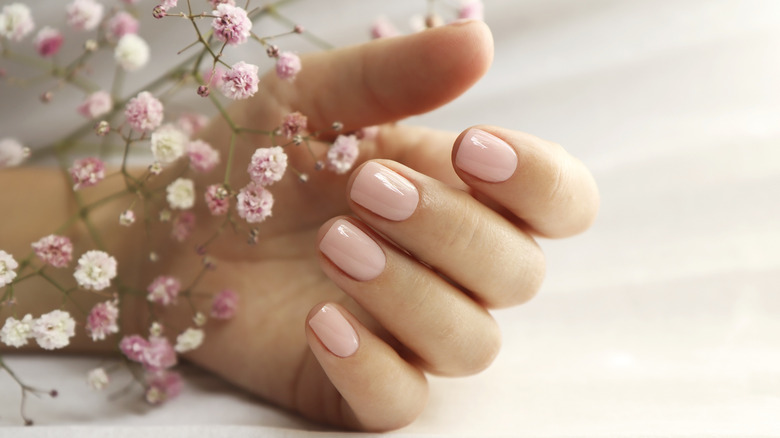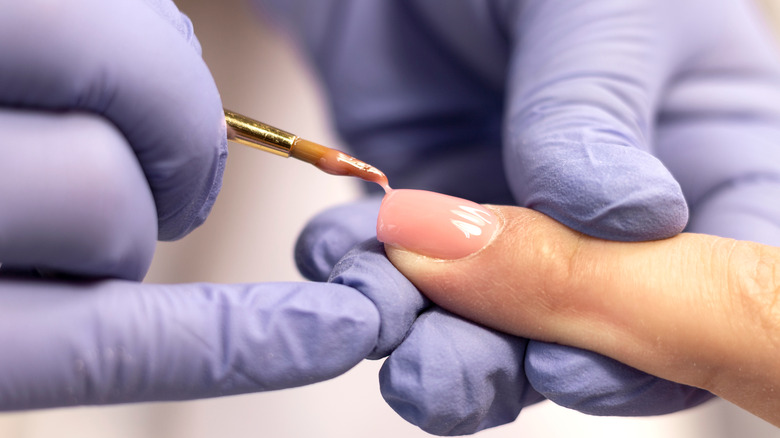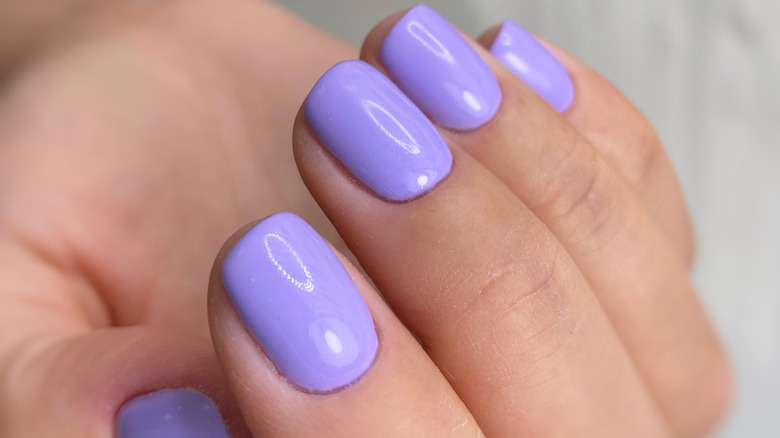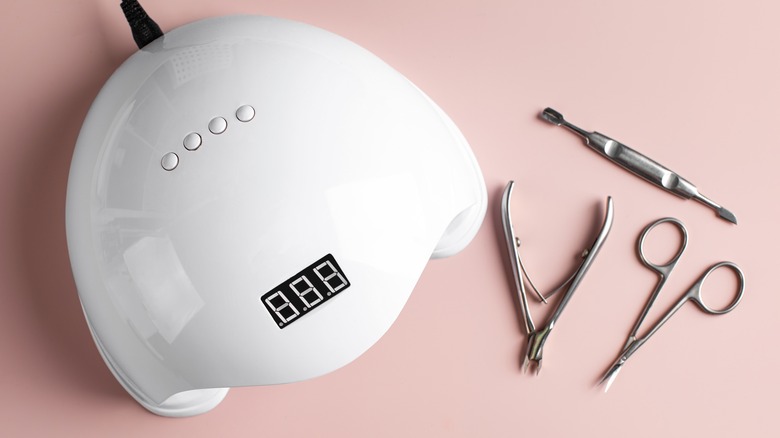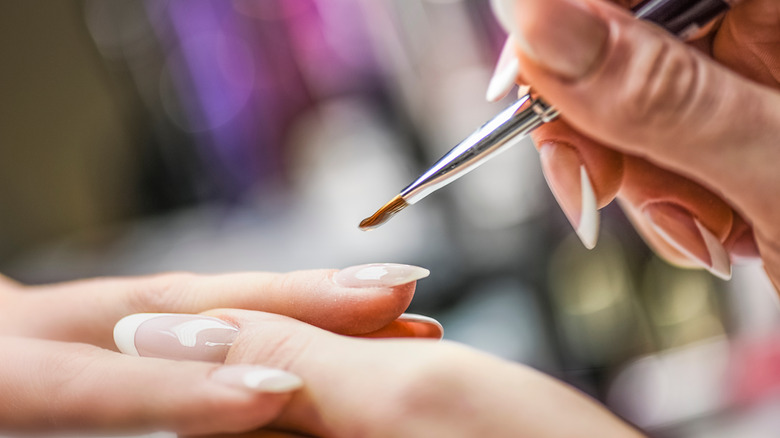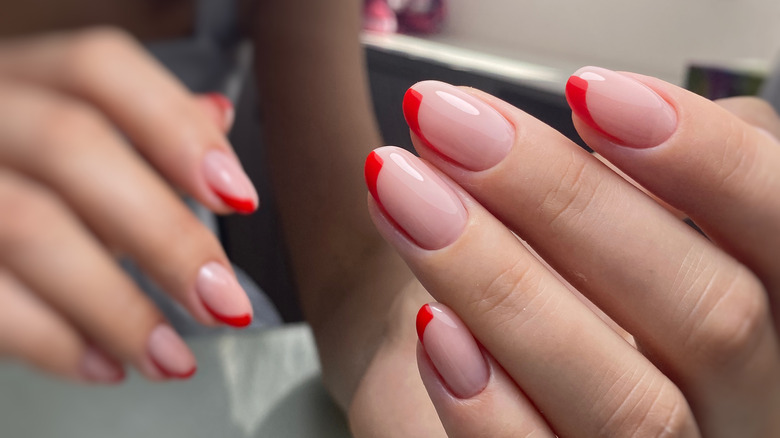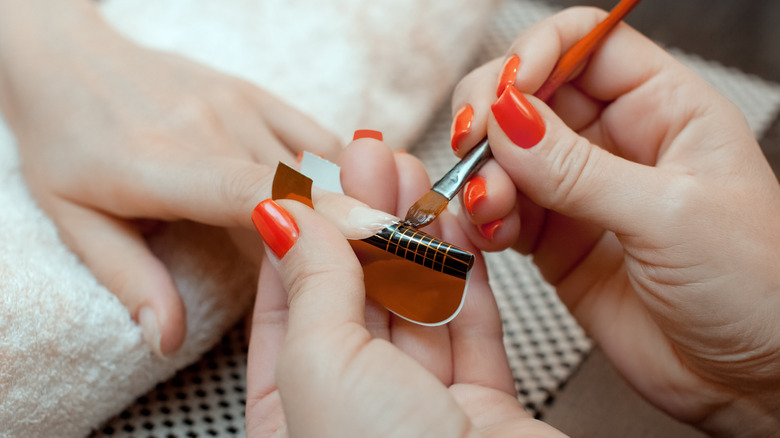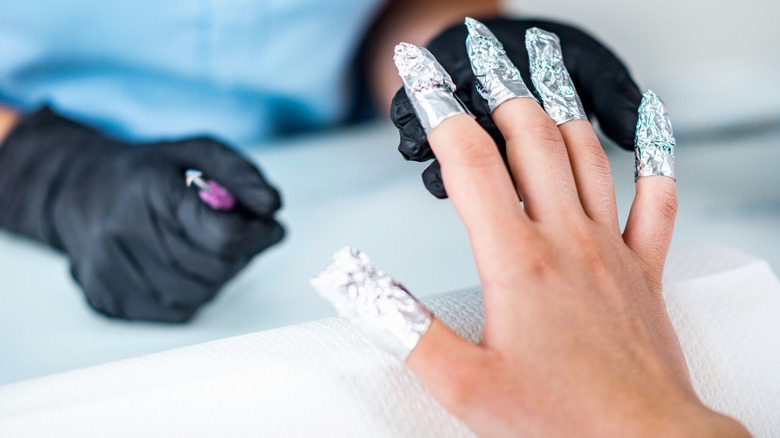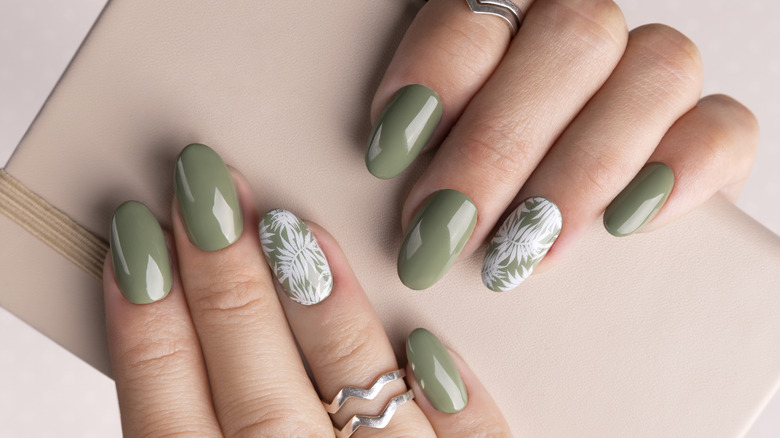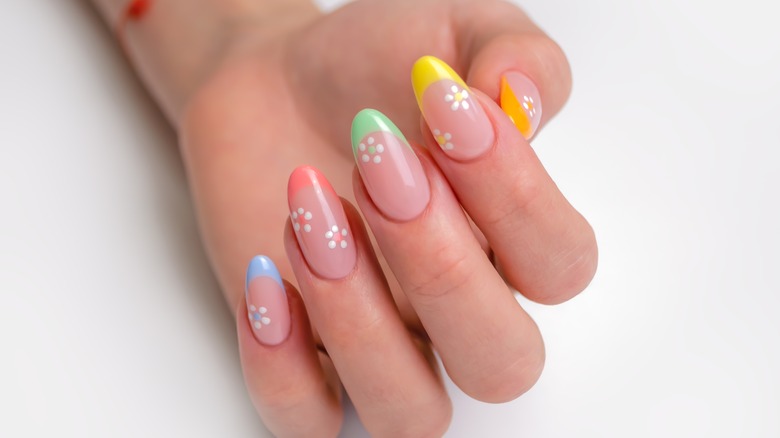Our Guide To BIAB Nails: The Gel Manicure That Has Actual Benefits
Nails are a lot like fashion; we use them to express ourselves and experiment with colors, shapes, and trends. For many of us, once we find a nail style that we love, it can be hard to ditch it and go for something completely different and fresh. For example, acrylic nails have been at the forefront of nail styles for decades, so when newer formulas for nail extensions began hitting the scene, many found the transition from acrylics to be a difficult one, After all, our acrylics have been working for us for so long. Why fix what's not broken?
What a lot of us don't realize, though, is the fact that just like the skin on our bodies, our nails contain pores. This means that any harsh chemicals and toxins from products we're putting on our nails have the potential to seep into our bodies. This can be extremely harmful over time, especially in the case of products like traditional acrylic which contain carcinogens linked to causing cancer, such as formaldehyde and benzene. So while it may seem strange to experiment with the new and upcoming nail formula trends, it's important to note that many are emerging with health benefits instead of health risks.
One such trend is a formula that took London by storm a few years back and soon afterward, thanks to Instagram and TikTok, became a worldwide fad. Enter: BIAB nails, which stands for Builder in a Bottle.
What is builder gel?
Builder gel is an overlay that is applied to the nails in order to provide them with a protective barrier. In turn, they are able to grow stronger, healthier, and more durably. There are two types of builder gel: hard and soft. Typically, hard gel is sold as a base layer and is often used as a replacement for acrylic. After a nail extension is applied, a technician will take a small brush and "build" a base that can later be shaped and painted on for a look similar to acrylics. On the other hand, soft gel is a builder gel that is closer to a gel nail polish and is not sturdy enough to build a base for an extension. Instead, this type of gel is used for painting on natural nails without a tip attached.
So how do BIAB nails fit into this category? When British nail company The Gel Bottle released a line of hard builder gels called BIAB, an acronym for Builder in a Bottle, the term caught on quickly. Although salons call this type of service a BIAB manicure, The Gel Bottle has since trademarked the name and expanded the line to include more colors. "Builder In A Bottle aka BIAB, are a range of soak-off gel builders ideal for creating strong overlays and as a strengthening barrier for natural nails," Tiffany Abbigaile, The Gel Bottle content creator, tells Woman & Home.
What are the main benefits?
For most, the number one reason for switching to BIAB is the long list of benefits it offers. Aside from being free of formaldehyde, formaldehyde resin, toluene, DBP, and camphor, as well as creating a protective layer over the top of your nails, BIAB aids in nail growth due to its safeguarding abilities, and allows you to go longer between appointments without chipping. In fact, those who bite their nails or are highly prone to nail breakage have shown great success with the protection of BIAB. However, it's important to note that BIAB's growth abilities can work a little too well sometimes. "It can also make your nails grow out very fast," creative nail expert and content creator Sadie Jordan tells Refinery29. "So you may need to have manicures more frequently if you don't like the look of regrowth."
What's more, while aiding in the process of new growth, the thick formula is self-leveling and can ease its way into cracks and other damages in the nail in order to reshape and repair weakened areas. Self-leveling also means that the result is going to look and feel more like a natural nail than acrylics do. "Oftentimes, other nail extension options can look thick and lumpy," celebrity nail artist Brittney Boyce tells Byrdie. "Because it's flexible like a soft gel, it's not as prone to damaging breaks, cracking, or brittleness," she continues. "The application and removal process are also not as damaging to your natural nails."
How similar is BIAB to acrylic?
With so many nail products on the market, things can get a bit confusing. But to understand how BIAB nails work in comparison to acrylics, we have to dig a bit deeper into their formulations. For starters, acrylics work by combining a powder-to-liquid ratio. The powder, which contains initiator molecules carrying chemicals like benzoyl peroxide and color pigments, meets with the liquid, which contains monomers (bonding molecules), and together they are able to create a hard — almost plastic-like substance — on the nail. While they don't need curing under a light the way gel does, they require an electric drill in order to be removed.
On the other hand, gel is scientifically very similar to acrylic in that it contains monomers. In fact, gel can almost be thought of as a "pre-mixed acrylic." Acrylic powders and liquids have already been polymerized to their full extent, but this can't happen with gel until it has come in contact with a UV light and is able to harden. Builder gel works in a similar manner. However, unlike acrylics, builder gel takes more of a focus on your natural nails by filling in cracks and adding a more flexible-but-protective layer.
Another bonus of a gel product instead of acrylic? "Gels have a harder, non-porous surface, so they're less likely to stain — like if you work with hair color," executive vice president and creative director of Artistic Nail Design Alisha Rimando explains to Vox.
What's the difference between BIAB and shellac or gel?
So if builder gel works similarly to gel polish with its semi-liquid consistency and ability to cure under a UV light, is it really just the same thing? Actually, it's not — though it's similar to a gel, builder gel is like gel polish's new and improved successor. Gel nail polish, along with shellac, is glossy, opaque, and runnier than a hard gel but sturdier than regular polish. The application of gel polish typically involves applying a base coat, then curing; applying two coats of color, then curing; and finally, applying a top coat and curing again. You should get about two weeks of wear from a gel manicure.
With gel polish, there isn't the ability to create an extension because the product itself is not thick or strong enough to hold the shape. If you'd like to extend the length of your natural nails and apply a gel polish on top, you will need to first start with an acrylic or builder gel base. This is actually the main difference between builder gel and regular gel nail polish. BIAB is a thick, hard gel, so it has the capability to be extended with nail forms or a short to medium-length tip. In fact, after a base has been created with BIAB, you can apply a gel polish overtop to achieve the color you're looking for.
What types of looks can be created?
BIAB's formula is completely different from regular gel polish, so it's not going to create the same exact look. Upon getting BIAB nails, in order to create a more natural look, the nail tech will start by forming a builder gel "apex," which is where the product comes into contact with your own nail. This apex will appear as a curved shape from the side, similar to the way our natural nails curve. Due to the thickness of the product, you can expect to see a rather plump and glossy result, which is able to be buffed and smoothed for a sleek and uniform appearance.
Because BIAB is essentially not a polish, don't expect to find a vast array of colors available. "BIAB usually comes in clear or colors like pink," nail expert Laurie Nicholl informs Woman & Home. But no worries if you are a fan of color because you can easily add a gel polish on top. "A gel nail color can be painted directly on top of BIAB or you can make the most of our BIAB shade range, [or] simply [add] top coat for beautiful nude nails," The Gel Bottle content creator Tiffany Abbigaile adds. \
This means that your nail design options are limitless. And because BIAB is able to be used on your natural nail or it can be extended, any length or shape is possible to create.
Salon vs at-home applications
Like any other nail service, we recommend visiting a nail salon to ensure the best BIAB application possible. Though it will take a bit longer than other applications — block out at least an hour and thirty minutes for your appointment — it will definitely be worth it. Similar to a gel manicure, a technician will start by prepping the nail for the product — this includes buffing and filing. Then, they will trim and clean up your cuticles. If you are adding length to your nails, the tech will apply special paper forms or molds around your finger in order to build the length and shape. Depending on the final look you're going for, they will then begin forming and structuring the gel on your nail, working from the cuticle outward. After curing in an LED/UV light, your nails are now ready for shaping and polishing.
Though BIAB started out as a professional-only product, it can now be purchased by the everyday consumer. However, just because the product can be purchased by everyone, doesn't necessarily mean that it should. Builder gel's consistency is very thick and takes a lot of practice and skill to master working with. On top of that, it requires the investment of a UV or LED lamp. Some who have tried the DIY method reported poorer results compared to salon applications, such as weaker bonding and faster lifting, especially when nail extensions are attempted.
How are BIAB nails maintained and removed?
"As a rule of thumb, BIAB will last around three to four weeks," Sanne, owner of Nailart Junkie salon tells Treatwell. "Then it can be either soaked off and re-done, or infilled." In order to get the most out of an appointment, Sanne warns that the first 24 hours after your service are crucial, and that during this time all heat sources, such as tanning beds, hot baths, and even doing the dishes, should be avoided. If you have BIAB nails and use any sunscreens, lotions, or household cleaning products, always wash your hands after use or apply gloves beforehand. And perhaps most importantly, never pick or pull at your nails — even if you're trying to remove the product.
Following these steps is especially important because if any chipping, peeling, or lifting does happen, you'll need to have a whole new set of BIAB nails applied. But luckily, removing them is a fairly simple process. First, just buff away the top coat with a coarse nail file. Next, you'll have to soak your nails in acetone. This can be done by soaking cotton balls in acetone and applying them to your nails by wrapping foil around them. After letting the cotton balls sit for 15 minutes, remove the foil and cotton and use a cuticle pusher to gently scrape away any gel. On the other hand, any nail growth can also be refilled with new gel similar to how acrylic is filled.
What is the average cost?
The cost of your BIAB manicure depends on where you live and what look you're trying to get out of your service. In fact, some salons even offer a BIAB base coat, which is simply a thin layer of BIAB to create a protective barrier underneath a regular gel manicure. This is an add-on service that typically costs around $5. For a full BIAB overlay with gel on top, the average cost is around $60 to $70 — not including any type of special services or nail art. From there, removal services and fills can run anywhere from $25 to $60.
If you do choose to go the at-home route, you may be able to cut back on costs, but the quality could be significantly less compared to a trained professional's work. All of The Gel Bottle's products are for professional use only, and a valid beauty license is required to order them from the brand's website. However, if you are skilled at DIY nails and have all of the essential equipment, it is possible to purchase off-brand BIAB and work your magic right in your own home. Brands like IBD sell their own versions of BIAB on Amazon, which typically cost anywhere from $13 to $20 for the building gel. This is the price of the builder gel only, so you will need to factor in an LED/UV lamp — which can cost up to $200 — shaping and trimming tools, top coat, and gel polish.
What are the risks?
BIAB nails are formulated with beneficial ingredients to help strengthen your nails, however, there are no nail applications that are 100% safe. Anytime you are exposing yourself to chemicals, you risk allowing those formulations to come in contact with your body. Additionally, any time drilling, soaking, or curing is involved, there is almost always an effect on the health and integrity of your nails. That being said, BIAB is one of the better choices out there as it is formulated without formaldehyde, formaldehyde resin, toluene, dibutyl phthalate (DBP), or camphor, and it's also vegan and cruelty-free.
The greatest risk that comes with BIAB nails is the chance of having an allergic reaction. TikTokker Laura Davis took to the social media app to call upon nail techs for some much-needed guidance after using BIAB. Following several uses, Davis began noticing her nails lifting off of the nail beds. Hundreds of nail artists and technicians assured her that she was having an allergic reaction to certain ingredients found in the BIAB brand she was using. As reported by Daily Star, experts at beauty retailer Just My Look have warned that BIAB products can contain ingredients that can cause onycholysis, or the separation of the nail from the nail bed. Treatment can take months and those who are affected may have to cut away at the separated nail as it grows out. Antifungal medication may also be necessary.
